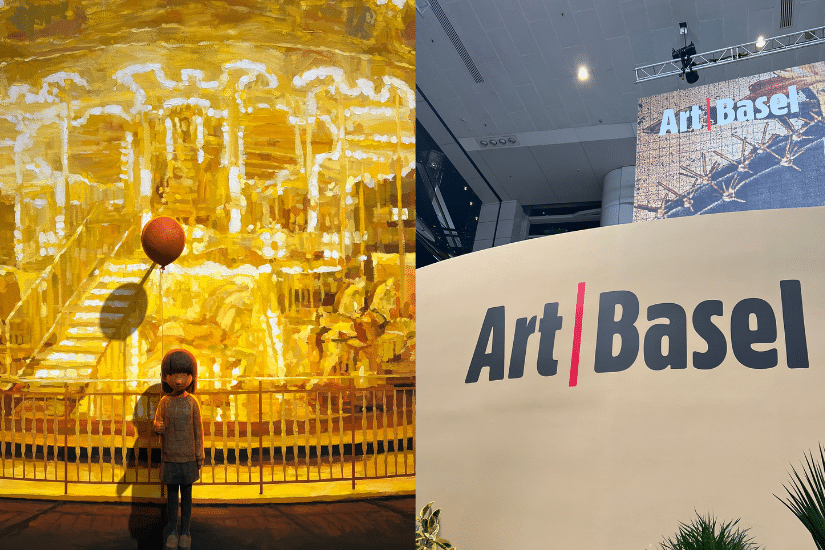The Art Basel Hong Kong Exhibition held in Asia in 2024 is an annual event showcasing top galleries from Asia and around the world. This year, a total of 242 galleries from 40 countries and regions participated, presenting a diverse artistic vision, historical materials, and forward-looking works by renowned and emerging artists. The Hong Kong exhibition has brought a fresh art experience to the audience among such a varied array of participating galleries!
The exhibition is divided into five main sections: “Encounters,” “Galleries,” “Insights,” “Discoveries,” and “Kabinett.” “Encounters,” curated by Alexie Glass-Kantor, showcases large sculptures and installations by globally renowned artists, breaking the boundaries of traditional exhibition spaces to provide audiences with a unique artistic experience, as it has been a major highlight in past exhibitions. This year’s theme is “I am a part of all that I have met,” with 16 large installations spread across two levels.
Here are ten highlights that ZTYLEZ has collected for everyone, taking you to savor the unique artworks of Art Basel together!
1. Liang Huigui “The World of Chance”
(2020, 2022)
Exhibition Area: “Art Gathering Space” (Encounters)
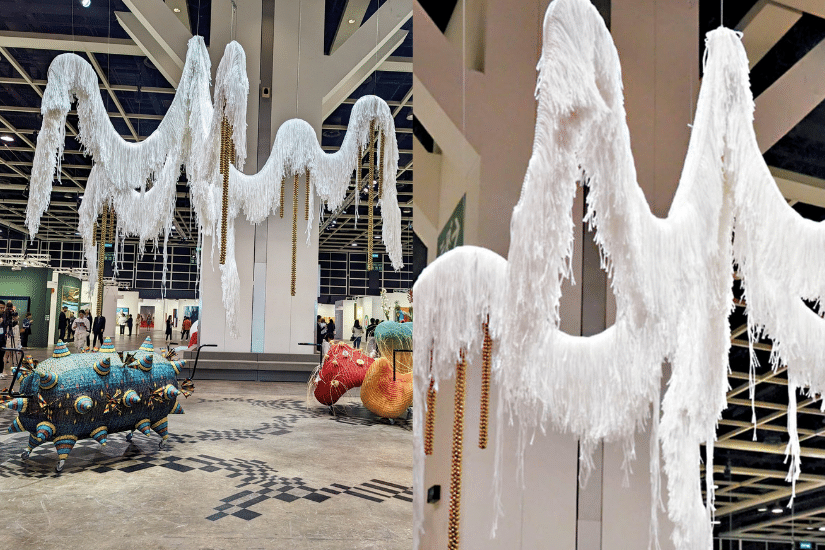
The artist Liang Huigui from Korea drew inspiration for his creations from traditional Filipino woven crafts. “The World of Accidents” consists of three pieces: “The RandingIntermediates -Underbelly Alienage Duo”, “The Intermediate -Five- Legged Frosty Fecund Imoogi”, and “Sonic Cosmic Rope – Gold Dodecagon Straight Weave”.
The two installation works feature two anthropomorphic vine sculptures that combine the traditional Philippine weaving technique of Binakol with 1960s Op Art, placed on a floor referencing the Binakol textile patterns from the Philippines. The interlacing geometric shapes represent waves, a pattern that is traditional to the Cordillera indigenous people, believed to symbolize protection from evil spirits. The third installation, hanging tassels, thick shiny bell ornaments, evoke a Korean folk tale about siblings fleeing to the sky to become the sun and moon.
She weaves with crafting techniques, creating different dimensions, including mythological narratives, spiritual and religious integrated ritual cultures, evoking endless associations with mythology, spirituality, and religious ritual cultures. As the bell strings descend from the sky, symbolizing transcending worlds beyond the heavens and potentials, sometimes being swayed, the sound resonates in the space, attracting many onlookers to experience.
Further Reading:
- 【Art March】Art Central 2024 Exhibition Guide!
- Feel the Magic of Tadao Ando’s Church Architecture with Wind, Light, and Water!
- Behind the Actress, Stories About Emma Stone!
2. Kaga Onsen “Ukiyo-e”
(2022 – 2023)
Exhibition Area: “Encounters Space”
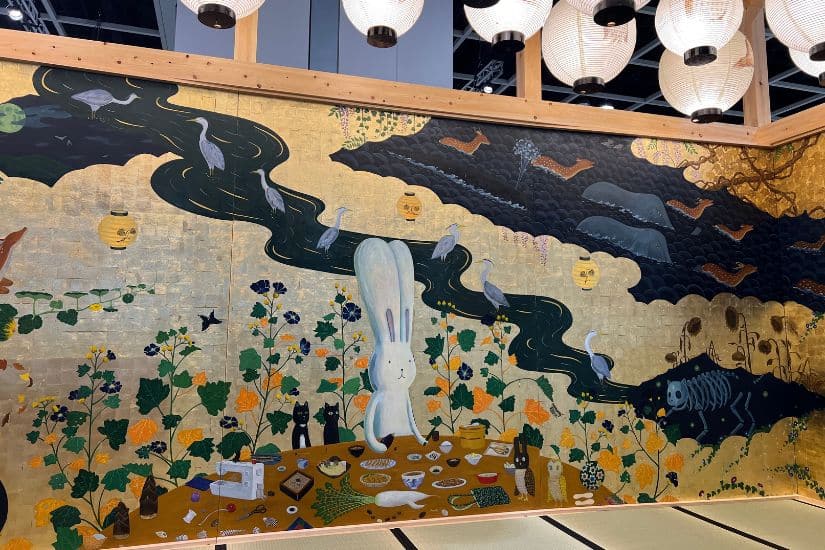
Artist Kaga Wen from Japan presents installation works in a theatrical form, drawing inspiration from small Kabuki theaters of the late Edo period. The composition, golden backgrounds, tatami floors, and paper lanterns in the pieces are rich in traditional Japanese architectural style, connecting with the characteristics of the Kyoto Rinpa school in the 18th century and the features of Ito Jakuchu, a prominent painter active in Kyoto during the mid-Edo period.
In the artwork, the rabbit spirit “Usacchi” is inspired by the classic “pooka” from Irish folklore, representing another aspect of the artist’s self. Usacchi is seated at a table in the center of a golden garden, surrounded by food and items symbolizing the artist’s late mother, Kazuko. Usacchi is holding eggplants and cucumbers, symbolizing the departed, and these small details showcase the artist’s cultural experiences in Japan and Europe. The intricate stage design also captivates the attention of many spectators!
3. Adila Sulaiman “When You’ve Had Enough of Paradise”
(2024)
Gallery: “Art Gathering Space” (Encounters)

Artist Adila Suleiman from Karachi created an installation piece made from three hanging metal screens, with motifs in the screens intricately connected by stainless steel sparrow-shaped metal components.
Each accessory is crafted using hand-hammered embossing technique, drawing inspiration from the local folk art “chamakpatti” of Karachi and the exquisite silverware used by the Mughal royalty. The screen symbolizes the separation between this life and the afterlife, while the death of sparrows signifies a fresh start or entry into paradise. Particularly noteworthy, each sparrow is interconnected by a machine gun in place of bird claws, representing the forced separations caused by violence; and each bird sacrifices its life to the recurring violence, becoming a mourning for these atrocities.
The folding screen and sparrows are intended to provide people with a space for proactive reflection on the fear, war, and turmoil of this world, prompting contemplation on these themes.
Livia “Once Upon a Time”
(2020 – 2024)
Exhibit Area: “Art Gathering Space” (Encounters)
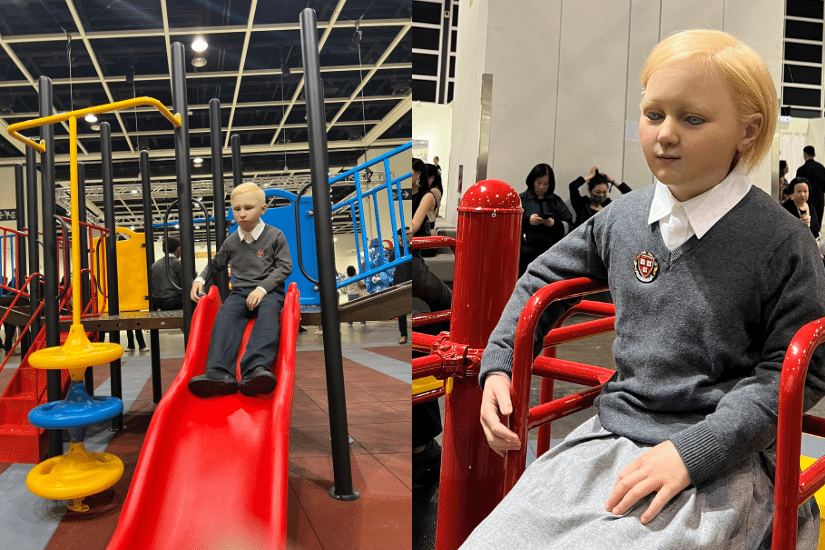
Chinese artist Li Wei uses common playgrounds in Hong Kong as the creative space for this installation. Imagining a group of world leaders reincarnated as seven-year-old children, placing six hyper-realistic child figures in various playground equipment. The scene is both familiar and chilling, making it one of the most striking pieces in the installation.
It is said that seven is the age when a personality is fully formed, and growing up to become an adult is considered the beginning of regression. The group of seven-year-old children are dressed in tidy school uniforms, inspired by hyper-real politicians, placed in various poses in this specially created playground. Recently, these spaces have become surveillance, alertness, and the loss of innocence, symbolizing the blurred existence of world leaders who may be either playing for pleasure or plotting misconduct.
When people enter the amusement park, the sensors of the amusement facilities are triggered, and people begin to suffer attacks of “bird songs,” making them feel both absurd and surreal, leaving them in a dilemma. The artist aims to prompt people to reflect on the importance of global politics through the calls of wild birds, which is no child’s play.
Mak2’s “Replicas within Replicas within Replicas within Replicas”
(2024)
Exhibition Area: “Encounters”
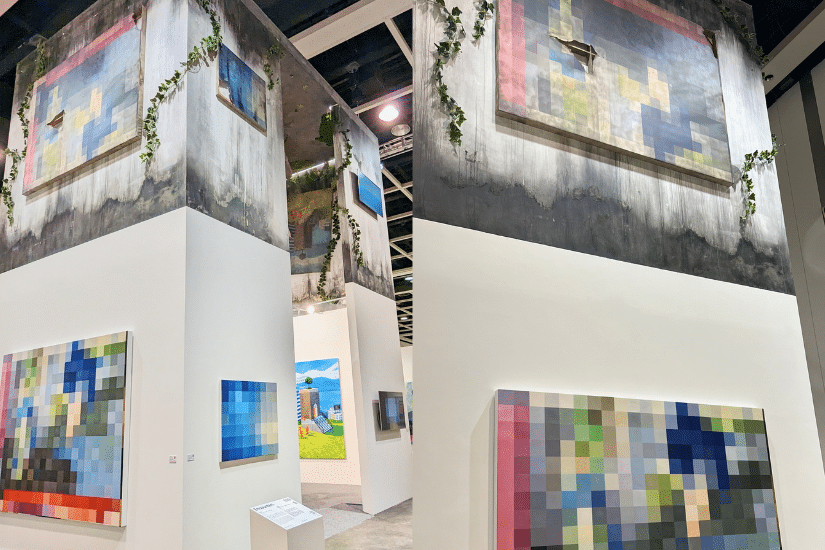
Artist Mak2 from Hong Kong replicates her work “Beautiful Homeland” next to her exhibition space, creating an identical layout with variations such as inversion, mirrors, and mosaics to explore the concepts of reproduction, evolution, and simulation, showcasing a satirical take on the culture of plagiarism.
The work presents a triple mockery of plagiarism culture and the artist’s own work:
The first layer showcases the “Beautiful Home” triptych series by Mak Yingtung II, but the pieces were actually created by hiring a painter from Taobao to depict scenes from The Sims game, crafting a blurred line between reality and fiction;
Adjacent to the exhibition, two duplicated booths are juxtaposed vertically, with the lower part being a complete replica of Mak Yingtung II’s works at the Dessart Gallery booth, where the triptych has been simplified into a single painting, presented with a mosaic effect;
The third layer is a mirrored version of the lower booth, though this version is in ruins, full of mold, overgrown wild grass, and skewed artworks. People can only speculate if this belongs to the art world of 200 years in the future, a dystopia, or is simply the artist’s satire on appearances.
6. Naminapu Maymuru-White “Larrakitj Forest”
(2024)
Exhibition Area: “Art Space” (Encounters)
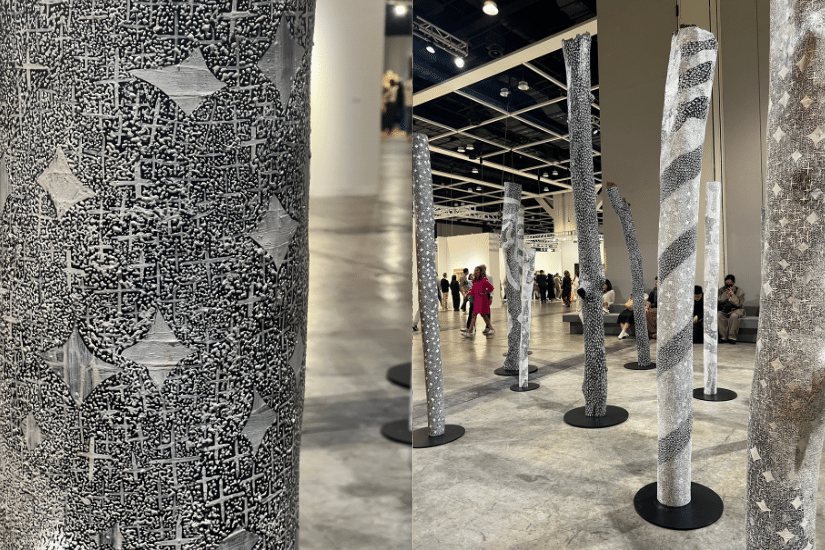
Australian artist Naminapu Maymuru-White uses several oval containers to symbolize the funeral ceremonies, cosmology, and painting traditions of the Yolŋu Aboriginal community in northern Australia.
The Yolngu people are indigenous to the northeastern Arnhem Land in the Northern Territory of Australia, and Yolngu art is a continuous dialogue on abstraction and expression, conveying the life meanings revered by the community and the intimate connection with the natural world. Artists depict the Milky Way on poles, conveying connections among all things: stars, water, sky, land, rivers, Larrakitj painting rituals, and the artists’ own hands, demonstrating the passage of time through ever-changing elements and the universe, affirming everything we encounter and the survival of the present moment.
7. Exhibition Area: Wong Hon Ming’s “Friendship First”
(2024)
Exhibition Area: “Art Space” (Encounters)
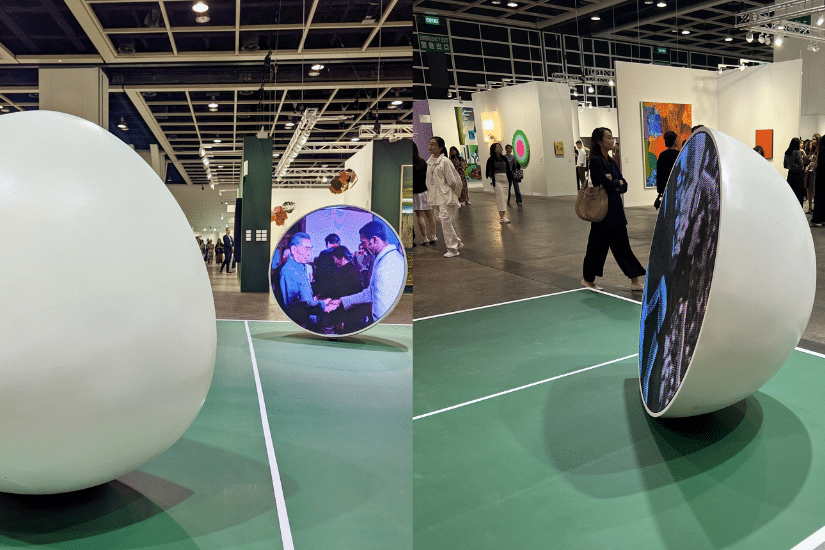
Singaporean artist Hanming Wong creates installations by sculpting: a green ping pong table is displayed on the floor, while two hemispheres serve as projection screens showing documentary footage from the Sino-American “Ping Pong Diplomacy” era in the 1970s, reflecting the artist’s interest in the relationship between the two countries, blending elements of pop culture and Cold War diplomacy.
The artist also collected images from publications such as “People’s Pictorial,” “People’s Daily,” “Time Magazine,” and “Life” magazine, documenting a ping pong friendship match in Beijing in 1971, which paved the way for the historic summit between China and the United States in 1972 during the peak of the Cold War.
8. Tsherin Sherpa “Stairways to Heaven”
(2023 – 2024)
Exhibition Area: “Encounters”
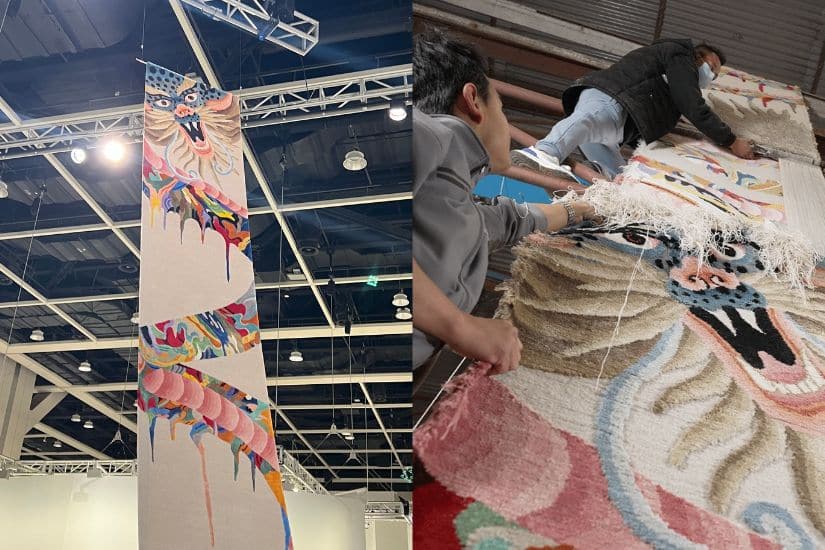
Artist Tsherin Sherpa from Nepal depicted a dragon that appears and disappears, spiraling upwards, on a ten-meter tapestry.
The artist draws inspiration from traditional esoteric totems, symbols, colors, and modes of expression, replacing the scales of dragons with dynamic swirling patterns. Through a contemporary perspective, they reinterpret one of the most common images in the making of Himalayan carpets. This pattern is used in multiple works by the artist, symbolizing the boundless power within this chaotic world, offering a potential interpretation from an exotic viewpoint of Nepalese material and traditional culture.
The collaboration with Mt. Refuge, a carpet studio in Kathmandu, is deeply intertwined with the rich history of carpet making in Nepal. For the artist, nothing exists independently but rather interdependently.
However, at the large-scale installation “Encounters” in Tai Kwun’s Hong Kong Tai Kwun, there are still many works showcasing various skills and stories, including a new multimedia installation art piece “Doan” created by Australian artist Daniel Boyd, on display outside the exhibition space until April 7; also, don’t miss the free “Light Projection Live” screening event!
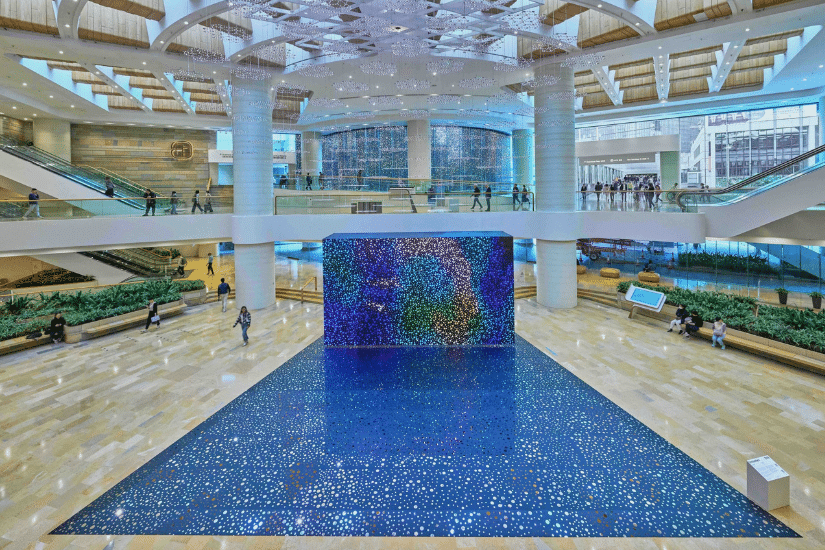
The artistic atmosphere of Art Month is not just limited to participating in exhibitions on-site, but in fact, various places in Hong Kong are filled with different artistic vibes!

